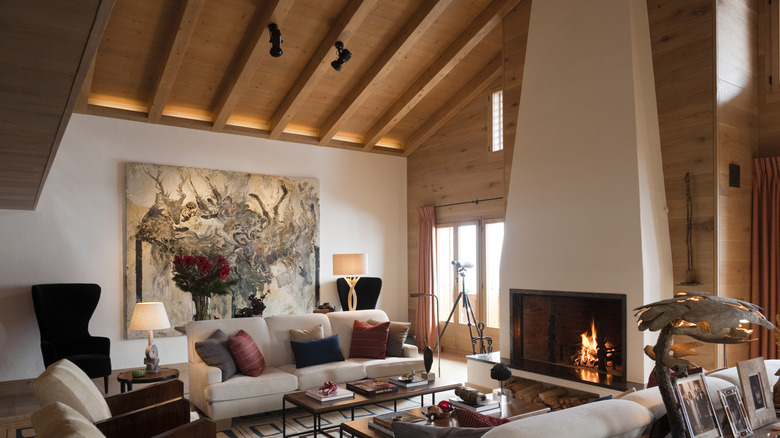Create Room Separation In An Open Floor Plan With A Creative Solution
After decades of popularity, open floor plans began to decline in the 2010s. The results of a survey by Rocket Homes found people nearly evenly split on the topic, with 51.2% favoring open floor plans and the other 48.8% preferring traditional homes. If you are one of the people that prefers a more traditional floor plan but is stuck with an open one, we may have a great solution. By adorning the ceiling just over one specific space in your open floor plan, you can create a sense of separateness while maintaining a cohesive design.
When looking for a way to separate spaces in your open floor plan home, don't forget to look up. A carefully designed accent ceiling adds character to the space and creates a focal point for specific areas of the house. Regardless of the architectural style of your home, you can create subtle changes that make a big difference in the feel of the space using paint, molding, or wallpaper on the ceiling.
An accent ceiling is also not a new idea. Opulent designs, intricate paintings, and gold leaf have been used for centuries in private homes, public buildings, and historic churches. In recent decades, accent walls have been more commonly used than accent ceilings, but that may be changing.
Benefits of creating an accent ceiling
The ceiling is often an underused space, but it is actually a fifth wall in the room. According to Sara McLean, color specialist for Dunn-Edwards, "Historically, most of the design and storytelling in structures was on the ceilings. In places like churches and castles, you used to have to look up to fully appreciate the space. Nowadays, everything has gone white, so it's nice to come back to fully utilizing the ceiling in design." (via San Diego Home/Garden Lifestyles).
For homeowners interested in creating distinct living spaces in an open floor plan home, an accent ceiling can provide an ideal solution for room separation. Highlighting the ceiling over the dining room table, in the living room, or in the kitchen delineates the different rooms and provides a sense of separateness, even without walls. It's similar to separating a space with an accent rug underfoot, but it's above your head instead. An accent ceiling also adds visual interest to a room. A well-designed ceiling draws attention and can become a focal point. When you select complementary colors, textures, and designs, the accent ceiling can tie the space together and enhance the overall aesthetic.
There are plenty of stunning DIY ceiling designs that are cost-effective. Depending on the type of ceiling you want to create, the size of the space, and the materials you select, enhancing your home in this way can be an affordable and quick solution to make an open floor plan feel more separate.
Options for using an accent ceiling for room separation
To create an accent ceiling, use molding, wood planks, or exposed beams to separate different living areas. Moldings or wood planks can be used to create anything from an elegant finish to a more rustic design. They can also simply be used to separate spaces, and then the rest of the surface can be covered with paint or wallpaper.
Painting an accent ceiling may not be a groundbreaking idea, but paint is a versatile and affordable solution for creating an accent wall to separate spaces. Paint is available in a wide range of colors and finishes, so the possibilities for bringing your vision to life are nearly endless. For instance, one ceiling paint color trend involves using jewel-toned colors. When selecting the paint finish, keep in mind that a high gloss finish will reflect light and brighten the space. However, if there are imperfections in the ceiling, flat paint is great for hiding them.
If you want a bolder statement or a more textured or graphic design, wallpaper can be used to create an interesting and dramatic accent ceiling. While most options can be used on the ceiling, there are a few things to know before adding wallpaper to your ceiling. A variety of designs are available to suit any style or design preference. Consider a bold geometric design for a modern architectural style or a textured paper that mimics the look of a natural material such as brick, metal, concrete, or wood for a unique room separation solution.


